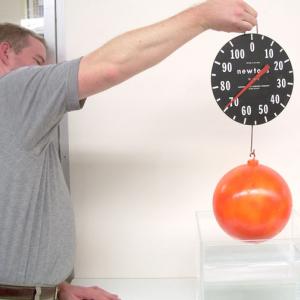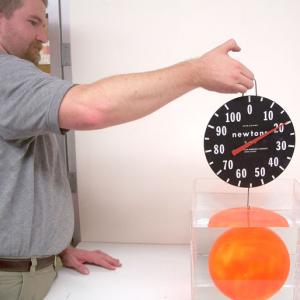College of Liberal Arts & Sciences
2B40.10 - Buoyancy - Bowling Ball and Spring Scale
Video Credit: Jonathan M. Sullivan-Wood.
Hang the bowling ball from the spring scale. Slowly lower the ball into the tank of water until it is completely submerged. Observe the change in the spring scale readings.
A block of known mass may be used in place of the bowling ball. Place a beaker of water on the digital scale and then tare. Pick up the block with the spring scale and lower it into the water until it is completely submerged but not touching the bottom of the beaker. The mass shown on the digital scale should be equal to the mass lost by the spring scale.
For a discrepant event you can immerse a 6 to 9 lb. bowling ball in the water. Unlike the 15 lb. bowling ball which sinks, the 6 lb. bowling ball we have will float quite high in the water even though the two balls have the same diameter.
- Paul Hewitt, "Answer to December Figuring Physics", TPT, Vol. 54, #1, Jan. 2016, p. 53.
- Paul Hewitt, "Figuring Physics: Going Deep", TPT, Vol. 53, #9, Dec. 2015, p. 517.
- J. Agostinho Moreira, A. Almeida, and P. Simeão Carvalho, "Two Experimental Approaches of Looking at Buoyancy", TPT, Vol. 51, #2, Feb. 2013, p. 96.
- Jelena Radovanovic and Josip Slisko, "Approximate Value of Buoyant Force: A Water-Filled Balloon Demonstration", TPT, Vol. 50, #7, Oct. 2012, p. 428.
- Concetto Gianino, "Microcomputer-Based Laboratory for Archimedes' Principle and Density of Liquids", TPT, Vol. 46, #1, Jan. 2008, p. 52.
- Irina Struganova, "A Spring, Hooke's Law, and Archimedes' Principle", TPT, Vol. 43, #8, Nov. 2005, p. 516.
- Erlend H. Graf, "Just What Did Archimedes Say About Buoyancy?", TPT, Vol. 42, #5, May 2004, p. 296.
- Jeffrey Bierman and Eric Kincanon, "Reconsidering Archimedes' Principle", TPT, Vol. 41, #6, Sept. 2003, p. 340.
- Dean S. Edmonds Jr., "Comments on the Buoyant Force", TPT, Vol. 40, #4, Apr. 2002, p. 196.
- Ellis D. Noll, "Confronting the Buoyant Force", TPT, Vol. 40, #1, Jan. 2002, p. 8.
- Paul L. Willems, "Specific Gravity with Electronic Balances", TPT, Vol. 36, #1, Jan. 1998, p. 10.
- Iain MacInnes and Rory McPherson, "An Illustration of Newton's Third Law", TPT, Vol. 34, #7, Oct. 1996, p. 400.
- Eric Kincanon, "Explanation of a Buoyancy Demonstration", TPT, Vol. 33, #1, Jan. 1995, p. 31.
- Ronald A. Hultsch, "An Application of Archimedes’ Principle: Eureka! I'm 28% Fat", TPT, Vol. 19, #6, Sept. 1981, p. 408.
- Robert Ehrlich, "H.9. Lowering a Weight Into a Liquid", Turning the World Inside Out and 174 Other Simple Physics Demonstrations, p. 104 - 105.
- "Fluid Statics", Harvard Instructional Physics Labs, https://sites.fas.harvard.edu/~scphys/
- Tik L. Liem, "What Is The Rock's S. G.", Invitations to Science Inquiry - Supplement to 1st and 2nd Ed. p. 144.
Disclaimer: These demonstrations are provided only for illustrative use by persons affiliated with The University of Iowa and only under the direction of a trained instructor or physicist. The University of Iowa is not responsible for demonstrations performed by those using their own equipment or who choose to use this reference material for their own purpose. The demonstrations included here are within the public domain and can be found in materials contained in libraries, bookstores, and through electronic sources. Performing all or any portion of any of these demonstrations, with or without revisions not depicted here entails inherent risks. These risks include, without limitation, bodily injury (and possibly death), including risks to health that may be temporary or permanent and that may exacerbate a pre-existing medical condition; and property loss or damage. Anyone performing any part of these demonstrations, even with revisions, knowingly and voluntarily assumes all risks associated with them.


